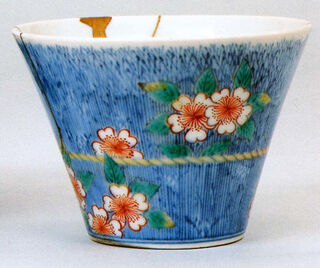Beauty
Symmetry's Infinite Discords
Asymmetry reflects transience and precariousness in life.
Posted November 29, 2021 Reviewed by Abigail Fagan
Key points
- While symmetry is one of the most important principles throughout the natural world, nature itself abounds in complex asymmetric patterns.
- Deviations from symmetry may indicate evidence of disease, genetic mutations, or exposure to toxins.
- The ancient Japanese technique of kintsugi reveals beauty in asymmetry.
There is an elaborately carved ancient gate, often considered the most beautiful in Japan, that is completely symmetrical except for a tiny design flaw. The story goes that the artist fashioned one carving upside down purposely so that the gods would not be jealous and angry of human perfection, explains Nobel Laureate Richard Feynman (1963).

Humans are innately fascinated by symmetry (Stewart, 2013). But where, asks Feynman, does symmetry come from? Nature, such as seen in water droplets or crystals or even our own bilateral body symmetry, is “so nearly symmetrical though no one knows why.” Feynman says. Perhaps, he says, “God made the laws only nearly symmetrical so that we should not be jealous of His perfection.”
The word “symmetry” derives from ancient Greek: “agreement in dimensions," or "having a common measure"(Online Etymology Dictionary). Symmetry is a harmony of proportions, reflecting balance and equilibrium (Weyl, 1952).
A precise definition of symmetry, though, is “elusive” (Stewart). In the natural sciences (e.g., physics, chemistry, and biology) and in mathematics, symmetry refers to a transformation or operation that leaves the structure essentially unchanged (Feynman; Stewart; Heisenberg, 1970). “By symmetry we mean the existence of different viewpoints from which a system appears the same” (Anderson, 1972), as for example, a triangle rotating in space (Engler, 1990). “It is only slightly overstating the case to say that physics is the study of symmetry” (Anderson). The first demonstration of that idea originated with Newton when he pondered whether matter on the ground obeyed the same laws as that up in the sky (Anderson).
Symmetry is one of the “aesthetic concepts” used by scientists, along with simplicity, order, coherence, unity, elegance, and harmony, as indispensable prerequisites for the creation of scientific theories (Engler). Throughout the physical world, there are also examples of objects with multiple symmetries (Stewart) and matter with broken symmetries, such as liquid crystals. "At a certain point, we should stop talking about decreasing symmetry and start calling it increasing complication" (Anderson).

We tend to equate symmetry in biology with health. Symmetry is one of the criteria we use to determine beauty, particularly in human faces (Rhodes, 2006; Foo et al, 2017). Deviations from symmetry can reflect a "departure from homeostasis;" they can indicate diseases, such as parasitic infection, as well as chromosomal mutations, genetic disorders, or exposure to toxins, and reflect poor overall fitness (Thornhill and Møller, 1997). These asymmetries may be the basis for rejecting a potential mate (Grammer et al, 2003; Zaidel and Hessamian, 2010; Leder et al, 2019). Subtle asymmetries, though, exist in most people (Thornhill and Møller).
While scientific disciplines regard symmetry “as one of the most important principles in nature,” (Leder et al), nature itself and the natural landscape abound in asymmetric patterns (Zaidel and Hessamian). For example, bilateral traits can sometimes demonstrate what is called “anti-symmetry,” as seen in the unequal claws of male fiddler crabs (Thornhill and Møller).

Both symmetry and asymmetry contribute to our aesthetic appreciation within nature (Gartus and Leder, 2013) but the complexity or simplicity of a stimulus, its novelty or familiarity, and its sense of proportion are also factors (Jacobsen, 2006). Even our emotional state, level of education, degree of interest, and cultural or economic circumstances, are relevant, as well as the situation itself: Viewing an object in a supermarket is a different experience from seeing it in a museum (Jacobsen).
References to the aesthetic impact of symmetry occur in literature. Willliam Blake called symmetry "fearful" in his 1794 poem, The Tyger. Virginia Woolf, in her early autobiographical musings, while viewing art during her travels through Italy, questioned the concept of producing beauty through symmetry. She wrote of "achieving symmetry by means of infinite discords"... "a whole made of shivering fragments" (Woolf, 1908). Small breaks in symmetry can be beautiful and create complexity within art (Gartus and Leder).

Nowhere is this notion of beauty in asymmetry more evident than in the Japanese aesthetics of kintsugi—literally “gold-joining,” an ancient lacquer technique that repairs broken ceramics with gold or other precious metals (Kemske, 2021).
Distinctly Japanese (though now embraced by other cultures), kintsugi developed in the late 16th or 17th century with the flourishing of the tea ceremony (Saito, 1997). It would not have developed in China, says Kemske, since the Chinese culture is all about perfection.
In the asymmetry of kintsugi repair, we find metaphoric references to "injured pottery" (Bazan, 2021) and "kintsugi scars" (Kemske), as if the ceramics have a human dimension. Without metaphor or narrative, plates would be just broken plates: Each kintsugi repair tells a story and is a “witness” to that story (Kemske).

The art of kintsugi reflects Buddhist philosophy—a celebration of transience—"time-consciousness." It accepts an asymmetric foundation that is precarious, imperfect, contingent, conditional (Wicks, 2005)—even reflected in the image of clouds obscuring the moon or the transience of cherry blossoms (Saito). There is, though, a simultaneous appreciation of a "now standpoint" and the "non-transitory aspect of time" (Wicks), as well as randomness and inevitability (Wolff, 2020).

Kintsugi creates objects more valuable than they were prior to repair. The choice to use gold is "not arbitrary:" its brilliance and purity remain refined and ageless, qualities juxtaposed and contrasted with the ephemeral quality of life (Kemske).
Special thanks to Lynn W. Reiser, MD, for her gift of Bonnie Kemske's beautiful book Kintsugi: The Poetic Mend.
References
Anderson P.W. More is different. Science 177 (4047): 393-396, 1972.
Bazan J. Mend the cracks. theexamindedlife: U.S. Catholic, February 2021, 7.
Engler G. Aesthetics in science and in art. British Journal of Aesthetics 30(1): 24-34, 1990.
Feynman R.P. Six Not-So-Easy Pieces: Einstein’s Relativity, Symmetry, and Space-Time. New York: Basic Books, 1963; 2011.
Foo Y.Z. et al. Predictors of facial attractiveness and health in humans. Scientific Reports (Nature) 6(39731): 1-12, 2017.
Gartus A. and Leder H. The small step toward asymmetry: aesthetic judgment of broken symmetries. i-Perception 4: 352-355, 2013.
Grammer K. et al. Darwinian aesthetics: sexual selection and the biology of beauty. Biological Reviews 78: 385-407, 2003.
Heisenberg W. “The Meaning of Beauty in the Exact Sciences,” (Peter Heath, translator), Address given to the Bavarian Academy of Fine Arts, Munich, 1970. (Retrieved online: 11/27/21).
Jacobsen T. Bridging the arts and sciences: a framework for the psychology of aesthetics. Leonardo 39(2): 155-162, 2006.
Kemske B. Kintsugi: The Poetic Mend. London: Herbert Press, 2021.
Leder H. et al. Symmetry is not a universal law of beauty. Empirical Studies of the Arts 37(1): 104-114, 2019.
Rhodes G. The evolutionary psychology of facial beauty. Annual Review of Psychology 57: 199-226, 2006.
Saito Y. The Japanese aesthetics of imperfection and insufficiency. The Journal of Aesthetics and Art Criticism 55:4: 377-385, 1997.
Stewart I. Symmetry: A Very Short Introduction. Oxford: Oxford University Press, 2013.
"Symmetry". Online Etymology Dictionary. https://www.etymonline.com/word/symmetry. (Retrieved 11/27/21).
Thornhill R. and Møller A.P. Developmental stability, disease and medicine. Biological Reviews 72: 497-548, 1997.
Weyl H. Symmetry. Princeton: Princeton University Press, 1952. (New Princeton Science Library edition, 2016.)
Wicks R. The idealization of contingency in traditional Japanese aesthetics. The Journal of Aesthetic Education 39(3): 88-101, 2005.
Wolff B. The pandemic shattered our world: how an ancient art can help us rebuild. Forbes. https://www.forbes.com/sites/benjaminwolff/2020/09/09/the-pandemic-shat…. (Retrieved 11/27/21).
Woolf V. "Shivering Fragments," 1908 Perugia. https://www.laphamsquarterly.org/arts-letters/shivering-fragments. (Retrieved online 11/27/21). https://www.britannica.com/biography/Virginia-Woolf#ref927502. (Retrieved 11/27/21).
Zaidel DW and Hessamian M. Asymmetry and symmetry in the beauty of human faces. Symmetry 2: 136-149, 2010.




